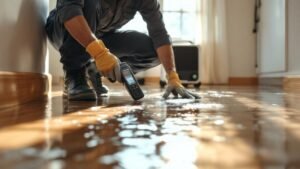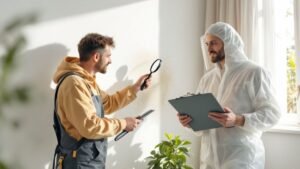When you first spot mold in your home, the instinct to grab a spray bottle and scrub it away is powerful. We all want a quick fix. But that dark spot on the drywall or the fuzzy patch in a damp corner? That’s often just the tip of the iceberg—a visible symptom of a much larger, hidden problem. If you’re searching for “mold removal companies near me,” you’re already on the right track by recognizing this isn’t a simple DIY job.
Get a Free Mold Inspection Now
Why You Should Hire Professional Mold Removal Services
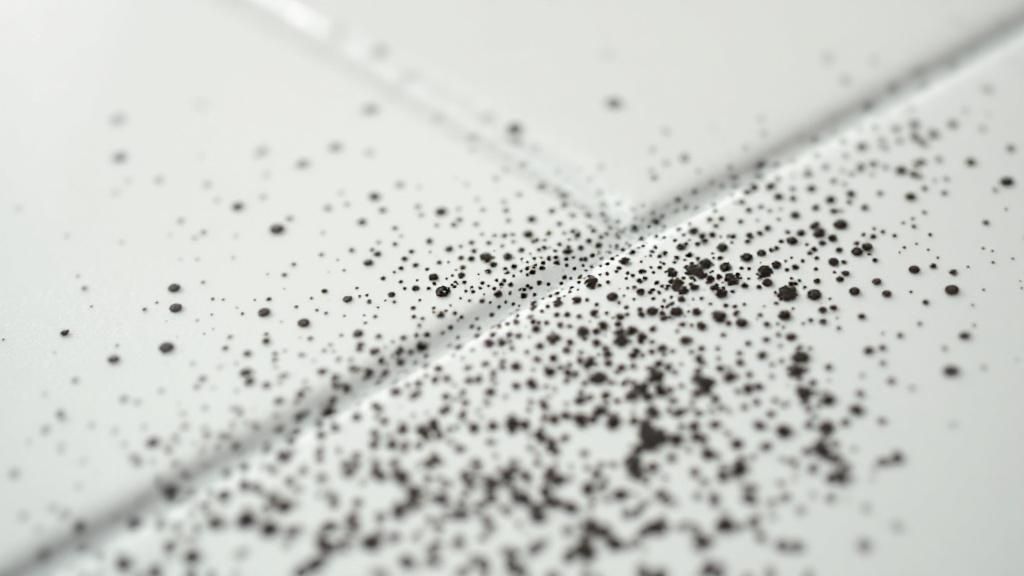
Trying to clean up mold yourself without understanding its full scope is a recipe for disaster. One wrong move can release millions of microscopic spores into your home’s air, turning a small, contained issue into a property-wide contamination crisis.
This is where the pros come in. A legitimate mold removal company doesn’t just wipe away what’s on the surface. They’re trained to find the source, contain the area, and eliminate the entire mold ecosystem to make sure it’s gone for good.
The Hidden Dangers of an Ineffective Cleanup
Think of a mold colony like an iceberg. The part you see is tiny compared to the extensive root system—the hyphae—that grows deep inside porous materials like drywall, insulation, and wood studs.
Spraying the surface with bleach might make the stain disappear, but it rarely kills the roots. Once you turn your back, they’re just waiting for the right conditions to grow right back.
We see this all the time in Los Angeles. A flat-roof leak in Sherman Oaks gets a slow, unnoticeable leak during a week of rain. Mold quietly thrives inside the ceiling for months before a faint stain finally appears. By that point, the contamination is far more severe than it looks from the outside.
Protecting Your Health and Your Property
Ultimately, the most important reason to hire professionals is safety. Mold exposure can trigger a whole host of health issues, especially for the most vulnerable: kids, the elderly, and anyone with existing respiratory conditions.
Common health risks we see linked to indoor mold include:
- Nagging allergic reactions like sneezing, itchy eyes, and mysterious skin rashes.
- Breathing problems, such as a persistent cough, wheezing, or asthma flare-ups.
- Chronic headaches and fatigue that seem to vanish when you spend time away from the house.
Beyond the health risks, unchecked mold growth will literally eat away at your home. It breaks down organic building materials, compromising your property’s structural integrity over time. There’s a reason the professional remediation industry has grown so much—it’s projected to hit $1,516.8 million by 2030. People are finally understanding why mold removal is so important.
Key Takeaway: Professional remediation isn’t just a cleaning service. It’s a technical process involving containment, safe removal, and air quality restoration. It’s one of the most critical steps you can take to protect both your family and your biggest investment.
Key Signs You Need a Mold Remediation Expert
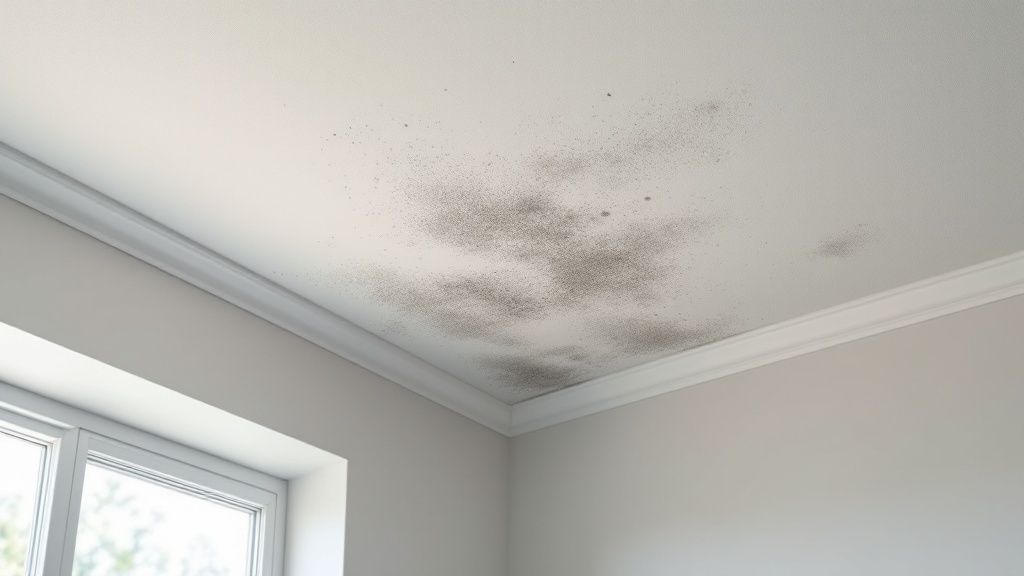
Before you start Googling “mold removal companies near me,” it helps to know what you’re looking for. The thing about mold is that it’s sneaky. The most dangerous infestations are often the ones you can’t see.
Your nose is usually the first line of defense. If you walk into a room and get hit with a persistent, musty smell—like damp earth or old, wet socks—that’s a huge red flag. It’s a classic sign of hidden moisture fueling microbial growth behind a wall or under a floor.
Physical and Sensory Clues
Sometimes, the evidence is more visual, but you have to know what to look for. Keep a close eye on surfaces near pipes, windows, or appliances, as these are common trouble spots.
You might be dealing with a problem if you notice:
- Warped or Bubbling Surfaces: When wallpaper or drywall starts to peel, bubble up, or feel soft, it’s a telltale sign that moisture is trapped behind it.
- Visible Discoloration: Everyone knows to look for black spots, but mold comes in all sorts of colors. It can be white, green, or even orange, often appearing as a stain or a patch of soot.
- Unexplained Allergy Symptoms: Do you find yourself sneezing, coughing, or dealing with itchy eyes more at home? If those symptoms magically clear up when you leave, your indoor air quality is the likely culprit.
Expert Tip: Pay attention to your water bill. A sudden, unexplained spike often points to a slow leak inside a wall—creating the perfect hidden environment for a massive mold colony to thrive.
When You Should Make the Call
It can be tough to tell the difference between a bit of mildew on the shower grout and a serious problem. While you can learn more about how to know if its mold in our other guide, some situations are non-negotiable and demand an expert opinion.
If your home has suffered any kind of water damage—a burst pipe, a leaky roof, a failed appliance—the clock is ticking. Mold can start to colonize in as little as 24-48 hours.
Don’t wait around for visible signs to pop up. A professional inspection can catch moisture issues early, long before a small problem turns into a full-blown infestation.
How to Find Reputable Local Mold Removal Companies
So, you’ve spotted what looks like mold. The next move is crucial: finding the right team to handle it. A quick Google search for “mold removal near me” will throw a ton of options your way, but let’s be clear—not all companies are created equal. Your goal is to find a licensed, insured, and certified pro who plays by the rules.
Start your search online, but dig deeper than just a slick website. Look for companies with a real local footprint and credentials you can actually verify. Sites like Google, Yelp, and Angi are great for checking out recent, unfiltered customer reviews. Pay close attention to what people say about communication, showing up on time, and how the company handled surprises along the way.
Verifying Credentials and Experience
The absolute non-negotiable credential you need to see is an IICRC (Institute of Inspection, Cleaning and Restoration Certification). Think of this as the gold standard in our industry. It means the company’s technicians have gone through serious training and know the proper, safe protocols for mold remediation. Frankly, never hire a company that isn’t IICRC-certified.
Next, ask them for proof of both general liability and workers’ compensation insurance. This is your safety net. It protects you from any liability if there’s an accident on your property while they’re working. A legitimate company will have these documents ready and won’t hesitate to show you.
Pro Tip: Always ask for local references. Hearing directly from a past client in a nearby neighborhood like Burbank or Glendale gives you invaluable insight into how they really perform on the job.
Comparing Your Options
Once you have a shortlist of a few companies, it’s time to compare them side-by-side. The difference between a true professional and an unqualified handyman can be night and day. If you want to dive deeper, our guide on how to choose the right restoration company in Los Angeles breaks down this decision-making process even further.
To help you spot the differences, here’s a quick checklist comparing a certified pro to a potential red flag.
Professional Mold Company vs. Unqualified Contractor Checklist
| Attribute | Professional IICRC-Certified Company | Potential Red Flags |
|---|---|---|
| Certification | IICRC Certified in Applied Microbial Remediation | No certifications or vague “mold specialist” claims |
| Insurance | Provides proof of General Liability & Workers’ Comp | Hesitant to provide insurance docs or uninsured |
| Process | Follows industry standards (containment, negative air) | Suggests bleach or simple spray-and-wipe methods |
| Quoting | Provides a detailed, written scope of work and estimate | Offers a low-ball quote over the phone without inspection |
| Testing | Recommends post-remediation clearance testing | Says testing isn’t necessary or dismisses its value |
| Equipment | Uses professional-grade HEPA air scrubbers & vacuums | Shows up with shop vacs and household fans |
This table should make it pretty clear. Choosing a certified professional isn’t just about getting the job done—it’s about getting it done safely and correctly the first time.
This infographic also highlights why bringing in a pro is so important.
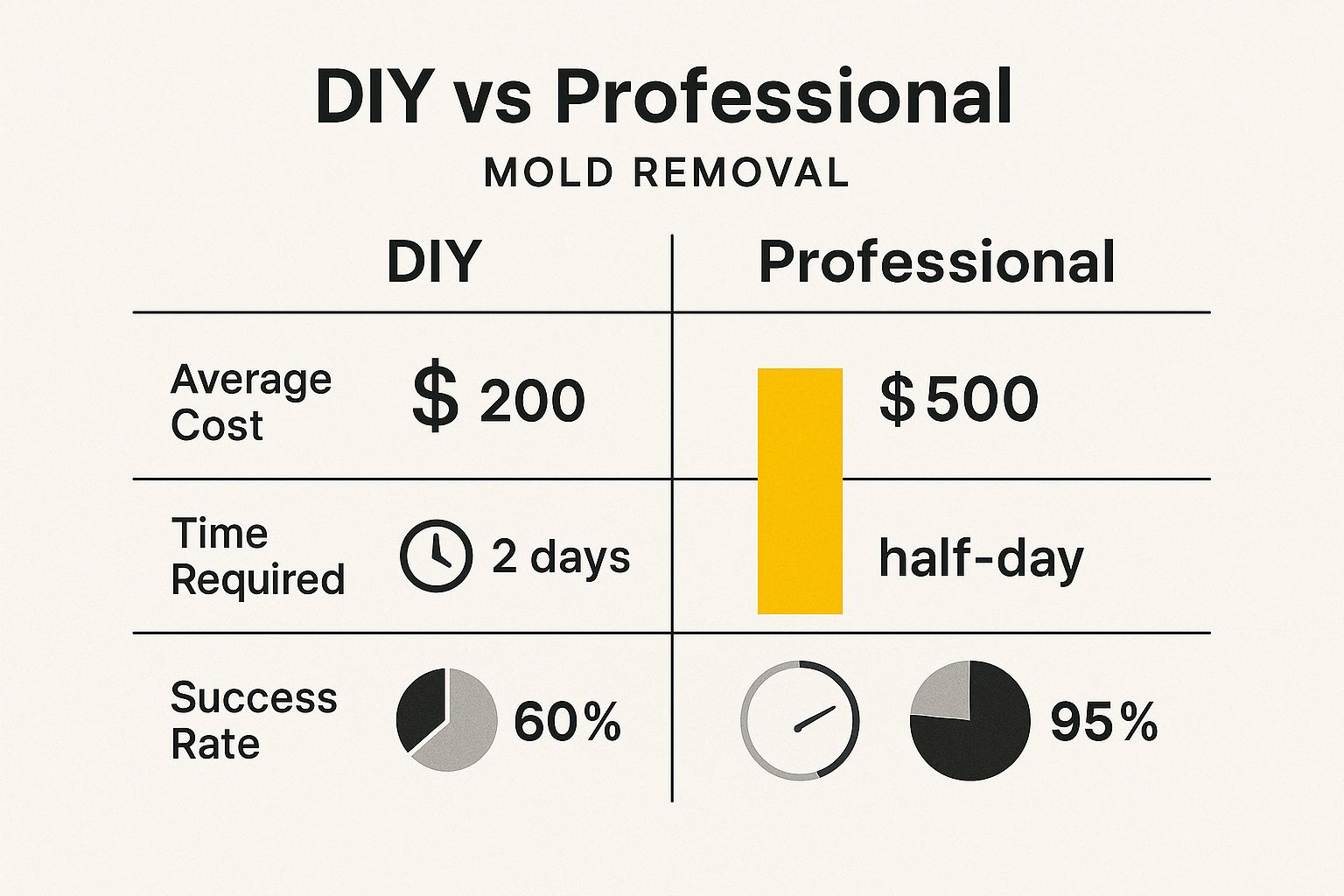
As you can see, trying to save a few bucks with a DIY approach often backfires. The much lower success rate means you’ll likely be dealing with the same problem again, costing you more time, money, and stress in the long run. Investing in certified expertise from the get-go is always the smarter move.
Vetting Your Shortlist of Mold Removal Companies Near Me
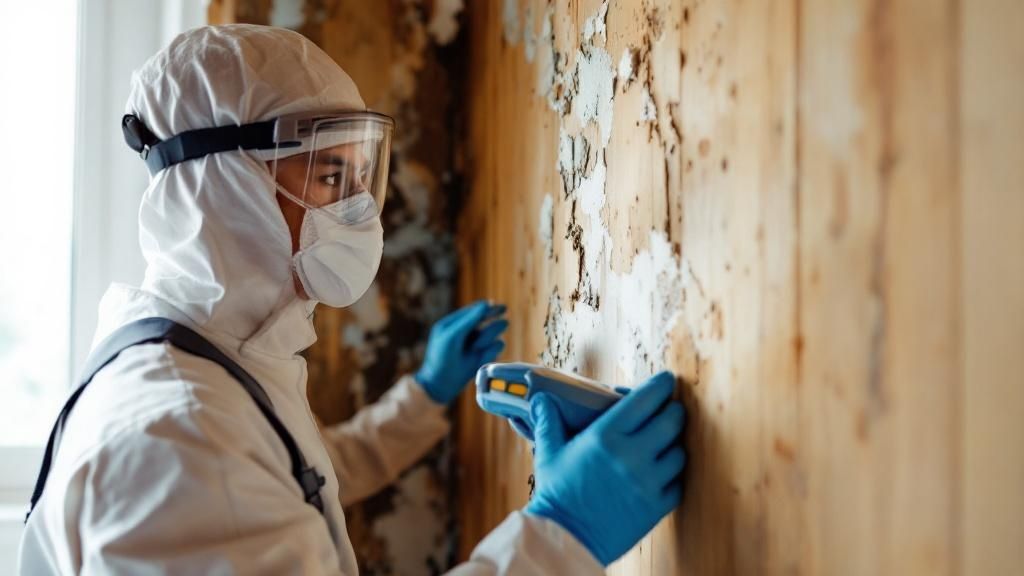
Alright, you’ve got a few IICRC-certified companies on your list. Now comes the most important part: the vetting process. This is where you separate the true professionals from the companies that just talk a good game.
Your first real test is the initial phone call. Pay close attention to how they handle it. A reputable company will be patient, transparent, and ready to explain their entire process. If they sound evasive, rush you off the phone, or can’t give you a straight answer, that’s a massive red flag. Move on.
Call (818) 336-1800 for a Free Estimate
Critical Questions for Your Initial Call
Your goal here is to get a feel for their expertise before they ever set foot on your property. A prepared, professional company will have no problem answering these:
- Licensing and Insurance: “Can you email me a copy of your contractor’s license and your certificate of insurance?” This is non-negotiable. Don’t just take their word for it; get the documents.
- The Remediation Playbook: “What’s your standard procedure for a project like mine?” Listen for the key terms that matter: containment, negative air pressure, and HEPA filtration. If they don’t mention these, they don’t know what they’re doing.
- Real-World Experience: “Have you handled a mold situation similar to mine before?” Ask them for an example, maybe a project they did in a Los Angeles neighborhood you know, like addressing a mold issue from coastal fog in Santa Monica. Their answer will tell you a lot about their experience level.
- Post-Remediation Verification: “Do you recommend or require third-party clearance testing after the job is complete?” The only right answer is “yes.” This independent verification is your unbiased proof that the mold is actually gone.
Understanding the On-Site Inspection and Estimate
The on-site inspection is where the rubber meets the road. Any legitimate company will tell you they can’t give a firm price over the phone without seeing the problem firsthand. Anyone who tries is just guessing.
The whole point of this visit is to assess the full scope of the contamination and, more importantly, figure out where the moisture is coming from. For a deeper dive into this, check out our ultimate guide to mold inspections.
When they send over the written estimate, it needs to be detailed and itemized. It should clearly spell out the scope of work, including the exact areas to be contained, the materials slated for removal, and the cleaning methods they plan to use.
A vague estimate that just says “mold removal” with a single price is the mark of an amateur. A professional quote will break down the costs for labor, equipment, and materials. This transparency protects you from surprise charges down the road.
This level of detail isn’t just good practice; it reflects industry-wide standards. In fact, North America leads the global mold remediation market precisely because of these stringent regulations and our established professional infrastructure. Sticking to these high standards is what separates a true expert from just a handyman with a HEPA vacuum.
What to Expect During and After Mold Remediation
Knowing what’s coming can take a lot of the stress out of the mold remediation process. Once you’ve picked a certified team, they’ll show up ready to tackle the problem with a methodical, multi-step approach that’s all about safety and getting the job done right.
The first thing you’ll notice is the crew setting up a containment area. This isn’t just for show. Using heavy plastic sheeting and negative air pressure machines, they’ll completely seal off the affected zone from the rest of your house. This is a critical step to prevent airborne mold spores from escaping and spreading while they work.
The Remediation and Cleaning Phase
With containment in place, the real work begins. The technicians, usually decked out in full protective gear, will bring in specialized equipment like HEPA (High-Efficiency Particulate Air) vacuums and industrial air scrubbers. These machines are designed to capture microscopic mold spores right out of the air, which immediately starts improving the indoor air quality.
Next comes the careful removal of any mold-infested porous materials that are too far gone to be saved. This often includes things like:
- Drywall
- Insulation
- Carpet and padding
For non-porous surfaces like wood studs or concrete, the team will use powerful antimicrobial agents to clean and disinfect them. The entire area is then meticulously wiped down and HEPA-vacuumed a second time to catch any lingering spores.
Verification Gives You Peace of Mind
Here’s a step that separates the pros from the amateurs: post-remediation verification. Any reputable company will strongly recommend (or even require) that you hire an independent, third-party industrial hygienist for clearance testing after they’re finished.
This unbiased air sampling is your proof that the mold is gone and the area is truly safe. It gives you documented evidence and, more importantly, total peace of mind.
The restoration industry is always improving, with new, eco-friendly solutions and technologies changing how effectively and efficiently mold can be handled. If you’re curious about how these changes might affect service costs down the road, you can get a glimpse into projected mold removal costs in 2025.
FAQs About Finding Mold Removal Companies Near Me
When you’re dealing with a potential mold problem, a lot of questions pop up right away. As a restoration pro in Los Angeles, I hear the same concerns from homeowners all the time. Let’s cut through the noise and get you some straight answers.
How much does professional mold removal cost in Los Angeles?
The price tag for mold remediation in the LA area can swing wildly based on how big the affected area is, where the mold is hiding, and what materials it has gotten into. A small, contained patch in an easy-to-reach bathroom might cost a few hundred dollars. But a serious colony from a slow leak that has spread through an attic or behind drywall can easily climb into the thousands. It’s crucial to get detailed, written estimates from multiple IICRC-certified companies.
Can I just use bleach on mold?
No. This is one of the worst things you can do. The EPA and every other expert in the field will tell you to put the bleach away, especially on porous surfaces like drywall or wood. Bleach might kill surface mold, but its water base soaks into the material, feeding the mold’s root system. Professionals use specialized, EPA-approved antimicrobial agents that eliminate the entire colony safely and completely.
Is mold testing required before removal?
Not always. If you can physically see mold, your first priority is safe removal. You don’t need a test to confirm what’s visible. However, professional testing by an independent industrial hygienist is essential when you smell musty odors but can’t find a source, when you need post-remediation clearance testing to verify a job was done right, or for legal/real estate transactions requiring third-party proof.
Does homeowner’s insurance cover mold removal?
Coverage for mold is tricky and depends on your specific policy and the cause of the moisture. Generally, mold from a “sudden and accidental” event, like a burst pipe you addressed immediately, may be covered. However, mold from gradual leaks, poor maintenance (like an old leaky roof), or high humidity is almost always excluded. Review your policy and call your agent immediately to understand your coverage. For a deeper dive, check out our comprehensive mold remediation FAQ page.
If you’re staring down a mold problem, waiting is the worst thing you can do. It will only spread and get more expensive to fix. Contact Onsite Pro Restoration for a free, no-obligation inspection. We’ll give you a clear, honest plan to make your home safe again.


